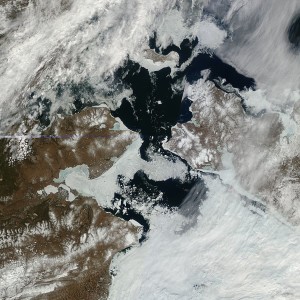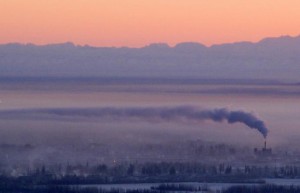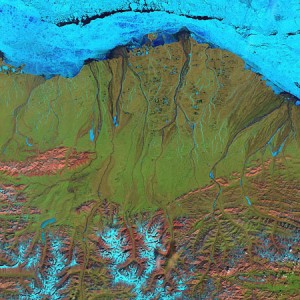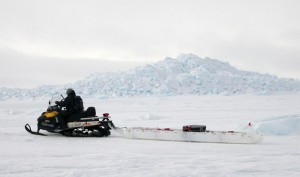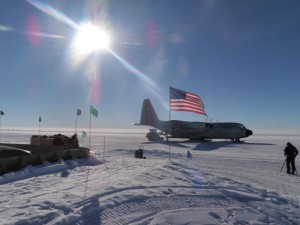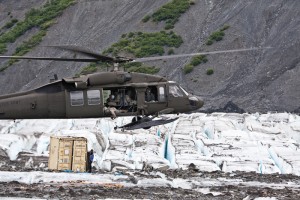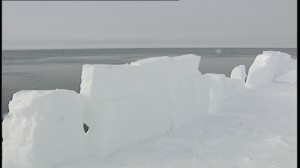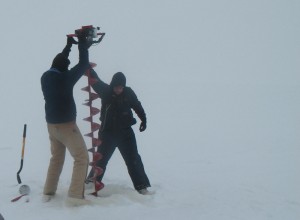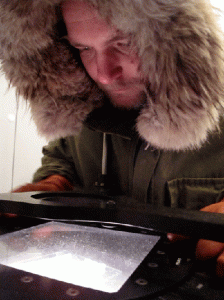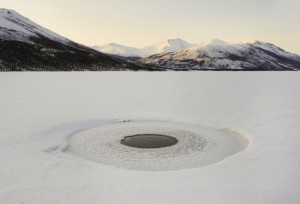Home » All Blogs » Modeling Arctic Waters
Instruments made to measure currents tug against their moorings on the sea floor. Others bob and whirl, catching currents, winds and tides with their rectangular wings spread just under wavetops in the Bering Strait west of Alaska. Ocean water is on the move. “There’s a strong connection between the world’s ocean currents and what comes […]
A time capsule of satellite imagery of the earth will become available to scientists this month. On June 28, digital imagery from more than three decades ago will be released by the Alaska Satellite Facility at the University of Alaska Fairbanks Geophysical Institute, NASA’s processor and distributor for this type of data. The images reveal […]
Liz O’Connell for Frontier Scientists – During winter in the Arctic it’s “night” almost all the time, but thanks to the new Visible Infrared Imaging Radiometer Suite (VIIRS) Day/Night Band (DNB) we no longer have to be in the dark about what’s going on with the weather. Here is a VIIRS/DNB image of the Alaska […]
Ned Rozell for UAFGI – This just in: 2012 was the coldest year of the new century in Fairbanks, and the second coldest here in the last 40 years. Fairbanks isn’t the only chilly place in Alaska. Average temperatures at 19 of 20 long-term National Weather Service stations displayed a cooling trend from 2000 to […]
Laura Nielsen for FrontierScientists We know that the Arctic holds unique climate conditions and a complex carbon balance. Tundra fires and thawing permafrost release carbon dioxide into the atmosphere, while unique ocean currents and cold waters prompt higher levels of ocean acidification. Methane emerges from sea and soil. The Arctic sea ice cover shrinks to increasingly startling extents. Plant life […]
Ned Rozell for UAFGI – As the northern end of the globe nods away from the sun at fall equinox, the amount of sea ice floating on the northern oceans is now at the lowest amount ever detected by satellites, a period that goes back to 1979. This new sea-ice minimum follows an extremely cold […]
Laura Nielsen for FrontierScientists – This week is International Polar Week, September 16 – 22, 2012. The event coincides with the Fall Equinox, when 12 hours of daylight will light every location on the planet. Polar Week aims to involve the public with research going on in the Artic and Antarctic through educational activities and […]
Ned Rozell for UAFGI – It’s not often that glaciologists help with the recovery of long-lost human remains, but military officials recently enlisted Martin Truffer for that purpose. The University of Alaska Fairbanks Geophysical Institute professor and graduate student Dave Podrasky came up with useful information on a Southcentral glacier that held plane wreckage and […]
Liz O’Connell for Frontier Scientists – Fairbanks, Alaska, September 4, 2012 – Three videos introduce the oceanographic modeling work from the University of Alaska Fairbanks (UAF). The video Modeling Ice in the Arctic, shows a regional ice model coupled with a global climate model. “The ice is not as stiff as it used to be,” said Kate […]
Ned Rozell for UAFGI – Minnesota is the Land of 10,000 Lakes, but Alaska has more than that in the great expanse of flatlands north of the Brooks Range. These ubiquitous far-north bodies of water — most of them formed by the disappearance of ancient, buried ice that dimples the landscape as it thaws — […]
Ned Rozell for UAFGI – Marc Mueller-Stoffels unscrews the top of a glass jar and invites a visitor to smell the powder inside. A sniff evokes the image of kayaking Prince William Sound or walking a beach in Southeast. “We call it ‘Instant Ocean,’” he says, returning the lid to the jar. Mueller-Stoffels, a doctoral […]
Geologic methane is seeping through the edges of thawing permafrost and receding glaciers in Alaska and Greenland, according to a study recently published in the journal Nature Geoscience. University of Alaska Fairbanks researcher Katey Walter Anthony led the study, which, for the first time, documents the widespread occurrence of these terrestrial sources of geologic methane […]
